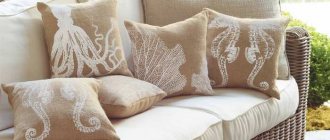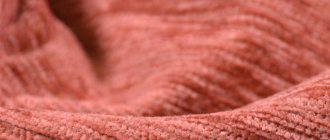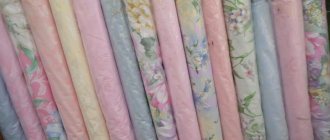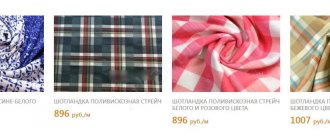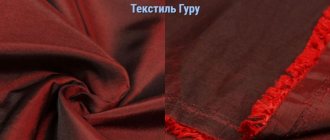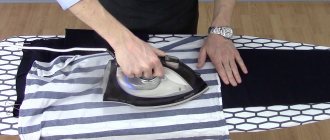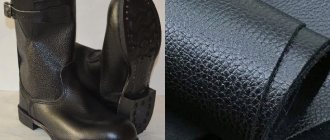In the group of environmentally friendly materials, this textile takes a leading place. Fabric for bags has been known for a long time. The scope of its application is not limited to packaging; today the material is used as a covering and is used in interior design and landscaping.
Everyone knows what burlap is. But its origin is not known for certain. Coarse fabric made from thick fibers of plant origin received technical status. A century ago, clothing made from burlap was common among peasants. You can see examples of homespun outfits in museum exhibitions dedicated to folk art and everyday life. Later, the material began to be used as packaging mainly for bulk products.
Description of texture
Photo gallery of burlap fabric
Burlap is a coarse fiber made from natural materials. It is made from harsh threads, due to which it has high tensile strength. The burlap fabric is porous, with a surface with a distinct relief, characteristic of a simple weave.
Moderately hard to the touch. There are gaps between the weft and warp threads to ensure optimal air exchange. The texture of burlap is similar in appearance to canvas. The photo shows that the threads of the material differ slightly in thickness. Thanks to the unevenness, relief is created, which can be played up in interior design using various techniques.
Composition - what is burlap made from?
What burlap is made from can be found on the product label. To produce the material, fibers of plant origin are used:
- linen;
- hemp;
- jute.
Expert opinion
Alyona
Fabric expert and technologist Alena Khlebnikova is ready to answer your questions.
Write to us
The canvases can use different types of threads, for example, flax and jute. Burlap is one of the most environmentally friendly materials.
Modern industry produces fabrics for technical purposes using synthetic fibers.
Types of fabric, distinguished by composition:
- Linen. The softest look of all in the group. Consists of flax fibers. Demonstrates antiseptic qualities.
- Jute. Tough, dense, wear-resistant material. Does not absorb moisture well.
- Mixed. Textile of medium hardness.
The path of material in history
Burlap is one of the very first materials that people learned to make. Thick fibers of plant origin were used for production. This made it possible to obtain dense fabrics and wear-resistant clothing.
Canvas was even used to sew the royal wardrobe. In the old days it was called hair shirt.
Initially, hemp fibers were used to make fabric. The canvas turned out to be strong and resistant to mechanical damage. The material had a characteristic texture that made things truly beautiful. Today it is almost impossible to find hemp burlap.
Modern burlap is a rough canvas made from processed plant fiber products. The main purpose of the fabric is to sew bags.
Production
The production technology of woven fabric is regulated by GOST 30090 - 93. Linen threads are most often used in weaving. In mixed versions, flax and jute are used predominantly in a 50/50 ratio. Less common are jute and hemp burlap without admixtures of other fibers.
In weaving, coarse bast threads made from flax, jute and hemp, characterized by a special structure, are used. The raw material is obtained from the inner part of plant stems. This method provides increased strength to the fibers, which is many times superior in properties to yarn from the surface sheath.
Textiles for technical purposes are made using the plain weaving method: by alternating overlaps of fibers directed perpendicularly. The density depends on the number of linear threads (weft). The state standard regulates the limits of the parameter: from 195 to 400 g/sq. m.
Burlap fabric of different densities
The yarn used in the production of burlap is thick. Thanks to this, the canvases are rough and moderately hard. Due to the peculiarities of weaving, gaps form between the warp and weft threads.
What standards are used in production? What do they take into account?
Manufacturing standards and material quality are established by GOST 5530-2004.
The density of the weave of the threads is the key technical characteristic of burlap and lies in the range of 180 - 400 g/sq.m. meter. It depends on the number of warp and weft threads per 10 cm of fabric.
In loose samples the ratio is 26x25, in dense samples it is 69x63. Density is calculated by weighing. Weight per square meter of natural fabric is from 190 to 450 g, synthetic - from 48 to 200 g.
The standard width of burlap is 95, 106 or 110 cm.
Characteristic
Detailed technical properties of bag fabric are given in the table below:
| Characteristic | Indicators _ |
| Raw material type | Natural plant origin |
| Purpose | Technical fabric |
| Yarn used | Bast fibers of jute, flax, hemp (hemp) |
| Method of weaving threads | Simple (smooth) |
| Density, g/sq. m. | 190 – 420 |
| Water resistance | Low |
| Hygroscopicity,% | 13 – 18 |
| Moisture absorption rate | Below average |
| Standard width of canvases, cm. | 106, 109, less often - 95 |
Open to see the entire table
| Breathability | High, for dense fabrics above average |
| Steam conductivity | High |
| Electrification | Minor |
| Side | Double-faced canvases |
| Dyeing method | Plain canvases |
| Wear resistance | Increased |
| Manufacturers | Russia, Belarus |
| Standardization | GOST 30090 – 93 |
| Price | Available |
Summarizing all the indicators, we can conclude that burlap is an environmentally friendly material, easily absorbs moisture and prevents it from getting inside the package, and provides high air exchange. Bast fibers ensured the fabric's ability to withstand high loads.
The material is not subject to rotting and is easy to care for. Easy to wash in automatic and manual modes.
Kinds
Universal textiles are widely used in various fields: packaging, arrangement of gardens and parks, interior design, forestry, construction, furniture production. Burlap is also used for handicrafts in the manufacture of souvenirs, household items, for decorating clothes, and in sewing bags.
Decorative
Linen is most often used as decorative fabrics. They are soft, unlike jute and hemp. To make crafts, choose materials of low and medium density. Souvenir bags, covers, and gift wrapping are made from burlap. Decorated with ribbons, embroidery, lace.
In interior decoration, burlap is used in the form of canvases, panels, and curtains. Cafes in country, Provence and boho styles are often decorated with different types of this textile. Texture opens up possibilities for design ideas.
Furniture
Modern trends in interior design have led to the popularity of burlap of any kind. A canvas with a simple texture is used to upholster furniture elements, for example, the head of a bed, small sofas, and armchairs. Covers are made from fabric. Due to its high strength and practicality, the material retains its visual appeal for a long time. Ease of care and price, along with originality, play an important role in the choice.
Jute
Burlap made from jute fibers is the most durable and wear-resistant type of this textile. Rough, rigid fabric is used as packaging and finishing material. In design solutions, jute burlap is used to decorate wall panels and garden corners for relaxation.
Good dimensional stability allows you to make covers, souvenirs, and bags from jute. It can also be used as a canvas for painting, embroidery with floss or glass beads.
Clothes
Burlap is rarely used in clothing. For stage performances, shirts and historical costumes are sewn, emphasizing the ethnic direction. For sewing, it is advisable to choose fabric of lower density from linen yarn.
The presence of burlap can be seen in designer clothing and accessories. The material goes well with leather, smooth soft fabrics, airy lace and classic sewing.
Packaging
Depending on the type of product and the conditions of its transportation and storage, one type of burlap is chosen. Linen has an antiseptic effect, jute provides maximum protection from moisture getting inside the package, and mixed ensures long-term preservation of the contents in the bag.
Application - what can be sewn
You can sew home interior items from burlap yourself: bedspreads, curtains, tablecloths, pillowcases for decorative pillows, beach bags and backpacks in ethnic style. The main thing is to approach the design and choice of fabric wisely.
The material lends itself well to dyeing, printing and sublimation. You can decorate things made of burlap with leather ribbons, appliqués, embroidery, and lace inserts. Burlap is used for embroidery. The clear structure of the canvas allows you to abandon the use of canvas.
Areas of use
The traditional area of use for burlap is transportation, so the requirements for its characteristics are standardized. The standard quality of domestic material depends on its purpose and is determined by the requirements of GOST 5530-2004. The density of burlap can take values in the range of 180-400 g per square meter, and its width can be 110, 106, less often 95 cm.
The most extensive area of application for various types of burlap is the transportation and storage of various bulk cargoes, primarily food and agricultural products (with the exception of finely dispersed ones). Such packaging is reusable, environmentally friendly and reliable, but does not protect the contents from moisture, moreover, it is itself susceptible to rotting. Therefore, its use is allowed only under conditions of sufficient air exchange and the absence of excess moisture.
At the same time, hygroscopicity makes inexpensive, durable and natural burlap a common textile for cleaning, especially in technical buildings, as well as for the primary purification of various liquids. Burlap fabric is also widely used in construction. It is used as a leveling and absorbent pad when painting walls, ceilings, and floors, as well as shock-absorbing and noise insulation. In gardening, vegetable gardening and landscape design, burlap is used to cover plantings, lawns, and protect the root zone. In these cases, it is preferable to use varieties of material with less hygroscopicity.
A common use for burlap is in the manufacture of furniture and mattresses. Thanks to its dim background and uniform structure, against which bright objects stand out well, it is also used in the design of premises, especially creative studios and exhibitions, in theatrical productions, as well as for the creation of clothing and various accessories, especially bags, in an ethnic style. Thin linen burlap is often used for their work by artists, needlewomen and craftsmen.
Adviсe
Reviews from needlewomen show that working with fabric is not difficult. Some features still need to be taken into account.
How to process the edge of burlap
Textiles, due to their porosity and the presence of gaps between the threads, are prone to shedding of sections. This can be attributed to both pros and cons.
To make working with the material comfortable, experienced craftswomen recommend rinsing the fabric in water with the addition of PVA glue before cutting. This will help reduce thread fraying.
The edges are treated with a double hem, edging, and dense overstitching.
In the manufacture of small-sized products (napkins, table runners, etc.), it is permissible to use fraying for good, making fringe along the edges. To do this, you need to sew a fine zigzag seam around the perimeter, leaving allowances of the required size, then carefully pull out the weft and warp threads along the edge.
How to bleach burlap
It is not recommended to bleach finished products for technical purposes, including bags and packaging. In some cases you have to break the rules. The color palette of textiles is poor. To create designer objects, it becomes necessary to make the canvas lighter.
To do this, use bleaches according to the recommendations for their use. Important! When lightening fabric using “Whiteness”, it must be remembered that chlorine significantly reduces the strength of the fibers and the durability of the material.
How can you replace burlap - similar fabrics
The following materials are similar in texture and appearance to burlap:
- linen;
- cotton types of canvas;
- calico.
Textiles with a pronounced texture, characteristic of plain weave, can replace burlap. The choice depends on the purpose of the canvas.
For products for which wear resistance and the ability to withstand heavy loads are important, instead of burlap, you can use natural, mixed and synthetic fabrics with similar properties: cordura, tarpaulin, canvas, moleskin and other types of technical fabrics.
Scope of application of burlap
Initially, burlap was used for packing things. It was used to make bags for bulk products, to wrap fragile items and bottles. Parcels and letters were wrapped in burlap, with a wax seal placed on top.
Gradually, the scope of application of the fabric expanded. Now it is actively used in the interior:
- for finishing walls and ceilings;
- furniture design;
- sewing tablecloths, sofa cushions, curtains.
Finishing with burlap creates an atmosphere of country housing, comfort and tranquility.
Burlap clothing is a special branch of fashion. Dresses, sundresses, skirts, and jackets are made from coarse fabric. Mostly linen is used, as it is the softest.
There is an interesting fact associated with burlap clothing. At the beginning of her career, Marilyn Monroe posed for a women's magazine. There was criticism against her photographs that all the beauty of the actress lies in her flashy outfits, and she would try to look beautiful in a potato sack.
A few days later, a new photo shoot of Monroe appeared - she was wearing a dress made from a potato sack. The actress looked no worse than in a designer outfit.
Various accessories are made from the material - backpacks, bags, hats, hair decorations. Embroidery on rough fabric creates an original style.
Burlap is used for fishing and hunting. Camouflage fabric is made of jute, painted in sand, gray, green colors. It is used as a camouflage covering for traps, huts, and tents.
Canvas with a seamless texture are used by artists to create paintings. The colors on it look different than on canvas, and the paintings acquire volume. The material is used to make theatrical scenery and costumes.
The material is used in construction and industry. It is used to make a filter for various liquids. The walls are covered with fabric for sound insulation and surface leveling.
The material is used in needlework to create various decorations. It makes original packaging for gifts and flower bouquets. Drink bottles wrapped in burlap look beautiful. Pieces of fabric are used in making cards and toys.
You can even make flowers from burlap and decorate gift boxes, tablecloths, and curtains with them. They also sew small bags for storing spices, aromatic herbs, and coffee beans. Similar bags are made by the Ecology Light store.
New Year's wreaths and garlands made of rough fabric look beautiful. Embroidery fits well on canvas, so panels and embroidered paintings are made from it.
When cut, the edges of the canvas crumble. Finishing the edges can be difficult because the fabric is stubborn and doesn’t bend well. Usually the edges are left unhemmed, soaking them in a solution of PVA glue.
See how to use fabric in decoration:
